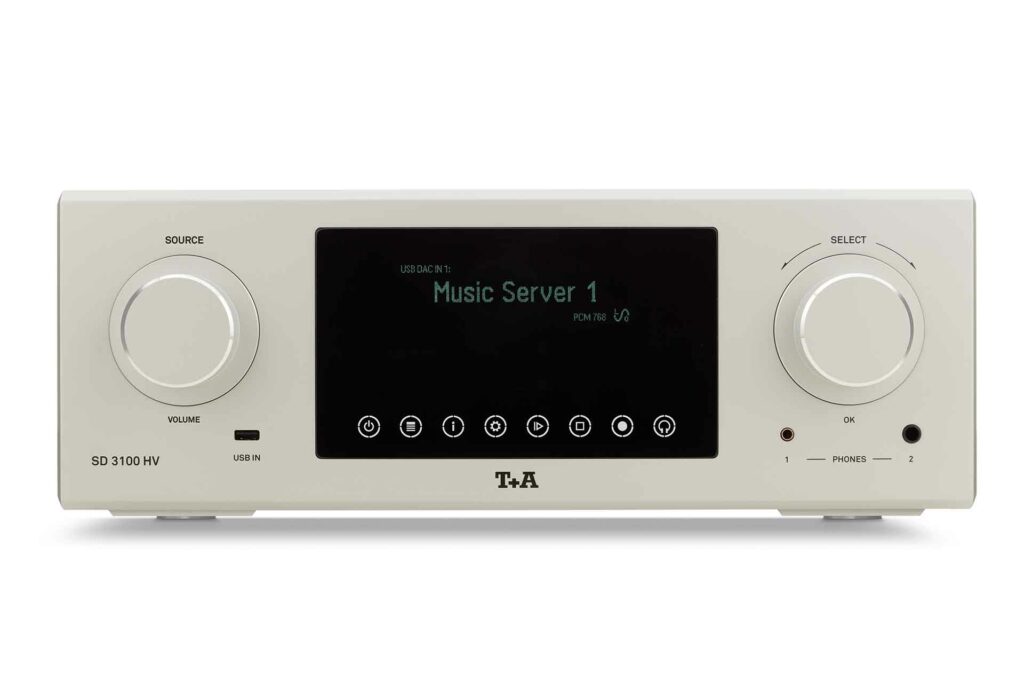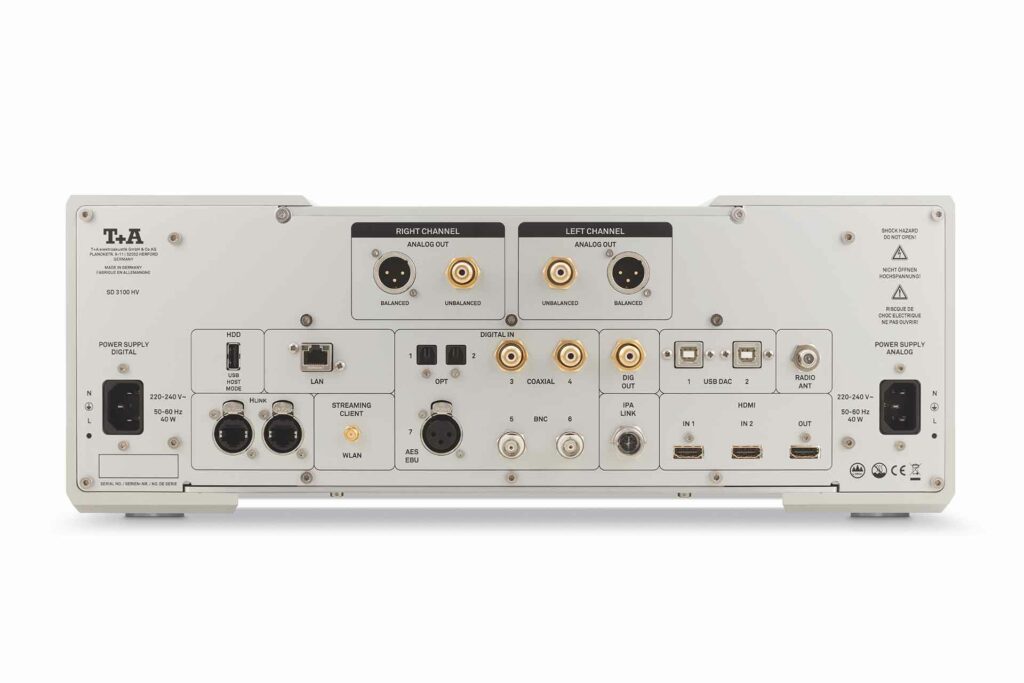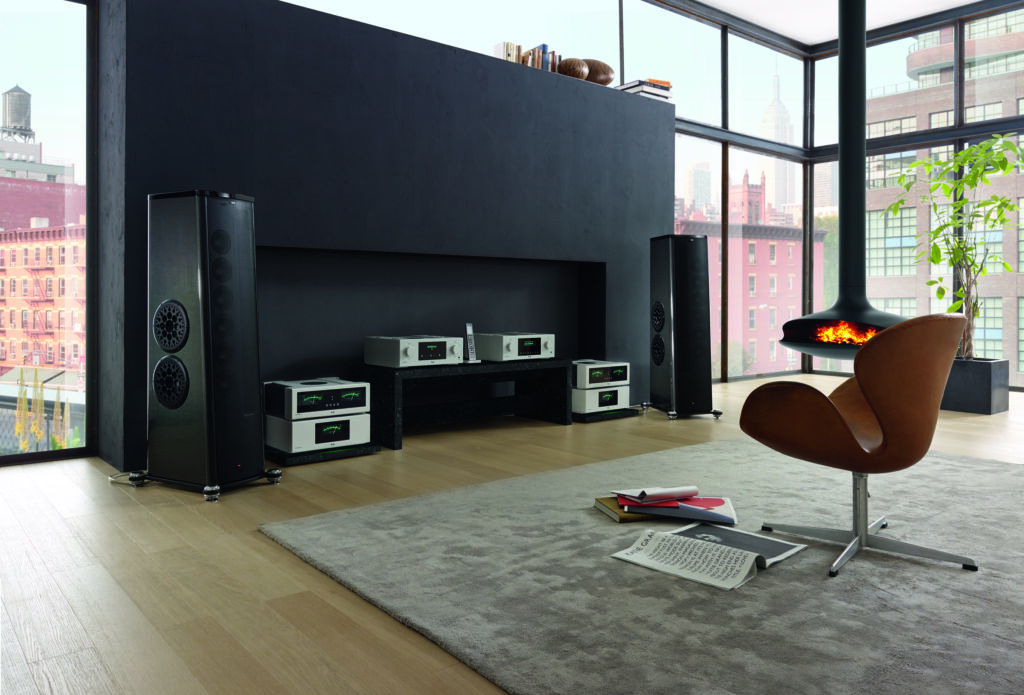By any reasonable measure, the T+A SD 3100 HV Streaming DAC is a world-class audiophile component with numerous features and a high degree of engineering excellence. Designed completely in house by a group of 12 full-time staff engineers and even two physicists, absolutely nothing was left to chance here or phoned in, so to speak.
One of the core principals of the SD3100 HV, and the entire T+A HV product line for that matter, is the use of high voltage rails on the power supply. Having built tube-based equipment for many years, T+A wanted to make solid state sound more like tubes. Their engineers reasoned because tubes typically operate with much higher voltages than transistor equipment, designing solid state gear to do the same would help achieve that goal. T+A was the first audio company to pioneer the use of high voltage power supply rail technology in solid-state components – something several of the world’s absolute best manufacturers now employ. Maybe imitation truly is the sincerest form of flattery.

What Makes the T+A SD 3100 HV DAC Special?
- T+A is a vertically integrated company where every component and every part of everything they make is designed in house. Some parts are manufactured by outside contractors, but all design, assembly, testing, and packaging is performed by the nearly 100 full-time employees on staff in the Herford, Germany manufacturing location.
- The T+A SD 3100 HV is intended as a standalone DAC used in partnership with a separate preamp and amp or integrated amp. A special version called the T+A SDV 3100 HV ($38,900) has a discrete volume controland may be connected directly to an amplifier.
- Virtually every imaginably digital source can be connected to the SD 3100 HV.
- The T+A SD 3100 HV uses a true, dual-mono design, input to output, with a machined-aluminum case and internally isolated compartments. Employing heavy gauge aluminum and no ferro-magnetic materials anywhere, this design helps prevent external and internal interference.
- Furthering the total dual-mono architecture, there are two power supplies, not one as in most components. One power supply is for the digital input and the other handles analog output.
- The system architecture is an all-discrete design without the use of op-amps.
- All DAC filer chipsets in the The T+A SD 3100 HV are designed in house. This means the device is somewhat futureproof, as software updates are available via the Internet.
- PCM (up to 768/24) and DSD (up to DSD 1024) are both decoded by the T+A SD 3100 HV.
- The SD 3100 HV may be connected to other T+A devices in the HV line by means of an H-Link cable. An included remote will therefore be able to control not only the DAC, but also an HV preamp and even a stereo amplifier. This worked to perfection in my system with my P 3100 HV preamp and A 3000 HV amp.
- Headphones may be directly connected to the T+A SD 3100 HV.
- A green-ish front display shows almost every operational function. Some information takes priority over others and the brightness of the display may be adjusted or turned off completely.
- All functions of the unit may be controlled from the remote or by the two large knobs on the front of the unit. There is even a balance control option.
- PCM conversion is performed by four 32-Bit, Sigma-Delta Dual-Differential DACs per channel. This four-fold conversion process ensures extremely high precision.
- There are four reconstruction filters for PCM decoding. Two are the widely used FIR filters used by many manufacturers. T+A also developed their own filter called a Bezier-Spline Interpolation Filter, which the company claims has a more smoothed out curve for a given number of sampling points – thus making digital signals more closely resemble analog. There is one Bezier filter used in combination with an FIR filter and one Bezier only filter. I found the Bezier only filter to be my favorite and best sounding.
- There are two settings for true 1-bit DSD conversion that will slightly alter the sonics, allowing the listener to somewhat craft their own sound based on personal preferences.
- As a streaming DAC, it offers direct access to sources like Tidal, Qobuz, and several others, along with Internet radio. You can even stream from a smartphone via Bluetooth.
Digital inputs include AES/EBU, BNC, Coax, Toslink, USB, HDMI, DAB , LAN, and WLAN. Analog out is via XLR or RCA.
Why Should You Care about the T+A SD 3100 HV DAC?
This device is obviously intended for a world-class audio system. Its retail price alone warrants that distinction. However, when considering all design, engineering, assembly, testing, packaging, and shipping are done in house, overall product quality may be very tightly controlled. Most manufacturing functions, such as all machining operations, are also done in house. Internal components are designed by T+A and built to their standards. This even includes the DAC chips.
Perhaps best of all, T+A is a fiscally responsible company and charges a fair price for their components. While the retail price of the SD3100 HV is certainly not in any way budget-oriented, this DAC will easily and equally compare with, and quite possibly outperform, other competing products whose retail cost is perhaps tens of thousands of dollars more. Additionally, the entire HV product line possesses a simple design elegance making it very attractive. Everything about this device just exudes very high quality, which is T+A’s intent.

Some Things You Might Not Like About the T+A SD 3100 HV DAC
- There are no options for up-sampling, if that’s something you’re interested in. For PCM, there is of courseoversampling and anti-aliasing, of course, but it upsamples all PCM signals to 768/24.
- The T+A SD 3100 HV uses two standard AC power cords. Why? The dual-mono design. The The T+A SD 3100 HV has two power supplies, galvanically separated. Each one must be plugged into an outlet. While there are power cords included, if you replace your pack-in cords with more expensive power cables, just know that you’ll need to purchase two of them.
Listening to the T+A SD 3100 HV DAC…
Overall, the sonics the T+A SD 3100 HV produced in my system were simply magnificent. I immediately noticed a commanding bass presence from the first moment I cued up one of my favorite reference tracks. In fact, bass response has never sounded better in my audio system than with the T+A SD 3100 HV installed. Low frequencies sounded very detailed with no hint of smear or rumble at all. Bass lines were easily identifiable and separation of instruments such as a bass guitar and a kick drum was noteworthy.
There was also a level of clarity and accuracy I have seldom experienced in my audio room. I found the higher frequency presentation, such as alto saxophones, to be detailed and razor-sharp. Any song with a high, soaring horn was reproduced with authoritative dynamics. Cymbals exploded. Midrange was also very revealing and dynamic. Only one other DAC I’ve auditioned recently, the Bricasti M21 Platinum Edition, was very anywhere near as detailed and dynamic.
If I had any issues with the T+A SD 3100 HV it would be in two principal areas. One, the lateral side-to-side imaging was not as wide as I would like. The Bricasti M21 Platinum Edition DAC and even the PS Audio Direct Stream DAC II had a wider separation of imaging. Not by much but enough to be noticeable. For anyone who places a high value on imaging, this matters.
The second issue really pertains to personal preferences. I felt like the T+A SD 3100 HV leaned ever-so-slightly on the side of accuracy as opposed to having a warm, lush sonic signature. To be fair, I like a highly detailed, large-scale dynamic presentation, so I find no fault whatsoever with this approach. I’ve heard other DACs more on the analytical side and they were also very listenable. This is an observation and not a condemnation. It is merely pointing out a sonically different presentation based on personal preferences.
With the recent passing of Gary Rossington, guitarist and last of the original founding members of Lynyrd Skynyrd, I thought it fitting to highlight “Free Bird”, their most famous song, first introduced on their original 1973 album, (Pronounced ‘Lĕh-‘nérd ‘Skin-‘nérd). This version is a 192/24 download (copied to my music server). Though the SD 3100 HV, the opening strumming of the guitar strings sounded highly natural, almost as if a guitar were being played live in front of me. One of the challenges of this song is the multiple changes in pace and tempo. Regardless of how frenetic or relaxed, the T+A SD 3100 HV DAC rendered an incredibly accurate and dynamic presentation. With this DAC’s capacity for accuracy and large scale dynamics, coupled with the heightened sonics of a high-definition master, this version of “Free Bird” positively soared. RIP Gary Rossington.
With the 44.1/16 version of Harry Styles “As It Was” from the CD titled Harry’s House , the track begins as a synth-pop, 1980s-style mix reminiscent of groups such as Duran Duran and Tears For Fears. There was a very deep bass element throughout the track and the T+A DAC, with its excellent ability to accurately and cleanly reproduce bass, made the lows sound particularly remarkable. There was also a noticeable reverb in the early vocals, probably in keeping with a more pop-leaning sound. Typically, a highly synthesized pop-oriented song such as this is not going to be one of my favorites. However, I did live through the 1980s and I’m very familiar with this type of music. I actually enjoyed this track as portrayed with the T+A SD 3100 HV in my system.
Does the T+A SD 3100 HV DAC Have Any Resale Value?
Products from the T+A HV line are not at all plentiful on the used market. Principally, this is because they are designed for decades of problem-free use and owners of the various components tend to hold on to them. On the seldom occasions an HV piece of equipment is sold on the secondary market, they typically sell very quickly. It is not unreasonable to find them for sale at less than a 50 percent discount from full retail. Based on this, the resale proposition is excellent.
Who Is the Competition for the T+A SD 3100 HV DAC?
There are any number of $36,000-and-up DACs available on the market today. Rather than focusing on price, though, I thought it would be interesting to audition four DACs at four different price points to see how sonically close they were to each other – or how far apart.
- Compared to the PS Audio Direct Stream DAC II ($7,995), the T+A SD 3100 HV was in every way superior. And why not, given the mountainous price differential? Of course, given that the T+A is over four times as expensive, it naturally has features and capabilities decidedly beyond the DAC II. Interestingly, however, the DAC II was quite detailed in its presentation and surprisingly similar to the SD 3100 in that regard. Most unexpectedly, the Direct Stream DAC II had slightly wider side-to-side imaging as compared with the T+A SD 3100 HV DAC.
- Compared to the Meitner MA3 DAC ($10,500), differences in presentation were easily discerned. The MA3 had a softer, more rounded presentation. Imaging on the Meitner was wide and deep, but dynamics were comparably limited. Despite that, the MA3 delivered an eminently natural sounding. Of the four DACs in this comparison, the Meitner MA3 and the T+A SD 3100 HV were the only two with direct streaming capabilities. Meitner, like T+A, is well known for its engineering excellence and I felt the MA3 was a well-crafted product and would be welcomed in most any audio system.
- Lastly, the most difficult was with the Bricasti M21 Platinum Edition ($19,000). Both of these components are very, very good at what they do. Both are well designed and accomplish their principal function with brilliance. While the T+A had a more detailed presentation and ever so slightly larger-scale dynamics, the M21 held a slight edge in overall tonality and an inviting presentation. It also had wider side-to-side imaging. Front-to-back was identical. Bricasti also uses two power supplies, but they do not have the same level of galvanic separation inside the cabinet. And of course, the M21 does not have direct streaming capabilities. And it is about half the cost of the T+A SD 3100 HV. All in all, I consider both these DACs to be world-class products. Their sonic differences, retail price notwithstanding, are much closer than they are apart. Frankly, I would be really, really happy with either one of them.

Final Thoughts on the T+A SD 3100 HV DAC
It is a common reviewer’s lament to send the product under review back to the manufacturer. Such was the case with the T+A SD 3100 HV. It elevated my system’s sonics while at the same time looked so good in my rack alongside my T+A P 3100 HV preamp and A 3000 HV amplifier, with the green meters and displays glowing.
In the final analysis, the T+A SD 3100 HV performed so well it was a real pleasure to have in my system for an extensive evaluation. The range of features on this DAC are as complete as any product on the market. There are other versions like the T+A DAC 200 that combine a DAC and a preamp.
To be sure, this is a product intended for a very high-end audio system. When paired with similar digital components, it will make listening to music the magnificent experience all audiophiles want and expect. Anyone considering purchasing a new DAC with a retail price this lofty, or even more, should absolutely audition this component. The T+A SD 3100 HV DAC is loaded with features, engineered to incredible standards, has stylish good looks and the ability to make a digital signal converted to analog sound positively superb. So, is this a world class DAC? You betcha. I would rank the T+A SD 3100 HV as one of the best DACs available anywhere – regardless of price.




Sadly no measurements to support claims about these products, we are left to trust the inherently biased mind of the author. Of course we know why they aren’t provided, as when those biases are stripped away we see it is an illusion.
Darrell,
I don’t like your tone.
If you don’t like Paul’s reviews and/or my publication because we don’t measure gear – then please ask for a refund for what you paid to subscribe. Oh wait….
Ironically, I just had dinner with the CEO of T+A tonight in Seattle at Pacific Audio Fest and we discussed how much of audio that can not be measured. For us, the cost and logistics don’t work with our free editorial model.
You clearly think it is OK to troll us so please accept this invite from the publisher, CEO and owner to read somewhere else. Good bye.
My dream DAC. Soon, it shall be mine.
I believe in you.